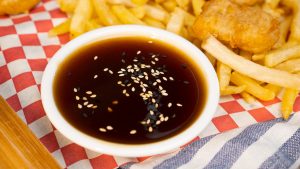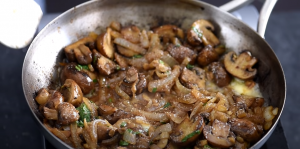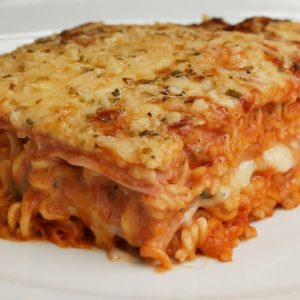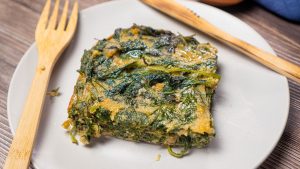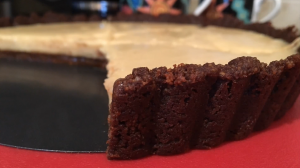Szechuan Shrimp, a classic Chinese dish, is renowned for its fiery, bold and complex flavors. This recipe beautifully merges the succulent sweetness of shrimp with a spicy, tangy Szechuan sauce. The flavors are a harmonious blend of sweet, sour, salty, and spicy, guaranteeing a delightful gastronomic experience.
There are a few ingredients in this recipe that are quintessential to Asian cooking and you may not have them readily available in your kitchen. The first is oyster sauce, a thick, savoury sauce made from oysters, which is commonly used in Chinese cuisine. The second is Asian sesame oil, which has a robust, nutty flavor compared to the more neutral taste of regular sesame oil. Lastly, sherry, a fortified wine from Spain, is used to marinate the shrimp. If you can't find it, a good substitute is a dry white wine or sake.
Key Ingredients for Szechuan Shrimp
Chicken broth: This forms the base of our sauce, providing a rich, savory backdrop for our other flavors.
Ketchup: Adds a hint of sweetness and a tangy punch to the sauce.
Soy sauce: Lends a salty, umami flavor to the dish.
Oyster sauce: Boosts the savory, umami flavor and adds a silky texture to the sauce.
Salt: Enhances the flavors of the other ingredients.
Sherry: Used for marinating the shrimp, contributing a subtle, sweet flavor.
Red bell peppers: Adds a sweet, slightly smoky flavor and a pop of color.
Long grain rice: Provides a neutral, fluffy base to absorb the spicy sauce.
Shrimp: The star of the dish, shrimp brings a sweet, delicate flavor and soft texture.
Cornstarch: Helps to thicken the sauce, giving it a glossy finish.
Cooking oil: Used for stir-frying the ingredients.
Garlic cloves: Imparts a spicy, pungent flavor that forms the base of many Asian dishes.
Fresh ginger: Adds a spicy, aromatic warmth to the dish.
Scallions: Brings a mild, oniony flavor and adds a fresh crunch.
Dried red pepper flakes: Provides heat and adds depth to the overall flavor.
Asian sesame oil: Adds a toasty, nutty flavor to the dish.
One reader, Faith Mccune says:





This Szechuan shrimp recipe is a game-changer! The flavors are bold and the shrimp is perfectly cooked. The combination of spices and sauces creates an explosion of taste in every bite. It's a must-try for anyone who loves a little heat and a lot of flavor in their meals.
Key Techniques for Mastering Szechuan Shrimp
How to stir-fry bell peppers: Heat a wok or large frying pan over moderately high heat until very hot. Add the bell peppers and stir-fry for 5 minutes until starting to blacken. Remove.
How to boil rice: Bring a medium pot of salted water to a boil. Stir in the rice and boil for about 10 minutes until just done. Drain.
How to toss shrimp with cornstarch: Toss the shrimp with the remaining 2 tablespoons of sherry and the cornstarch.
How to stir-fry shrimp: Heat oil in the wok or frying pan over moderately high heat. Add the shrimp and stir-fry for 3 to 4 minutes until just done. Remove the shrimp and add the remaining oil.
How to cook bell peppers, garlic, and ginger: Reduce the heat to moderate and add the charred bell peppers, the garlic, ginger, the chopped scallions, and the red-pepper flakes. Cook for about 3 minutes, stirring, until soft.
How to thicken sauce: Increase the heat to high. Add the broth mixture and boil for about 2 minutes until thickened.
How to heat through: Add the shrimp and sliced scallions and just heat through.
How to serve: Serve the shrimp with the rice and enjoy!
Whenever I’m craving spicy food, I go to my nearest local Chinese restaurant and order a delicious serving of Szechuan shrimp. Each tender shrimp is covered in a concentrated spicy sauce with green onions, bell peppers, and garlic for added texture and taste. It may look like a simple marinated shrimp dish with vegetables, but it’s actually sooo much more than that!
I’ve recreated a lot of Chinese shrimp recipes before like kung pao shrimp and shrimp lo mein. Those dishes satisfied my Asian food cravings, but honestly, nothing beats the strong and bold flavors of a traditional Szechuan style shrimp stir fry dish. You can get one of these at Tiger Noodle House, but I honestly prefer making this at home.
So, what is Szechuan food? Well, Szechuan or Sichuan cuisine is well-known for its hot and spicy flavors with just the right hints of sweet and savory goodness. It’s a bit different from Hunan shrimp and Imperial shrimp. These are other mild to hot and spicy shrimp dishes served in most Chinese restaurants. I’ve tried making some before, actually! Hunan shrimp doesn’t use any sweet ingredients. Meanwhile, a Szechuan shrimp recipe almost always uses sweeteners like sugar or honey, or sweet ingredients such as ketchup or hoisin sauce to balance out the spices. But, its flavors are far from the sweet and sour taste of the Imperial shrimp dish.
That’s why, when I was recreating this recipe, I wanted to focus more on lowering the spice level so that my family and friends would enjoy it as well. Not all of them could handle the heat! I didn’t use traditional Chinese spices like Szechuan pepper, Szechuan peppercorns, chili oil with fermented black beans, hot bean paste, or chili paste for this recipe. Instead, I used simple dried red pepper flakes so it’s still moderately spicy and delicious. Although, if you do want to retain some of the heat, then you can make your own separate hot Szechuan sauce recipe, which is what I did since I couldn’t miss out on the spice!
Besides the spices, you can also try and switch out the sherry wine with some Shaoxing wine for a more authentic flavor. It’s basically a Chinese rice wine with a distinctive flavor that’s somewhat sweet and vinegary. And then, mix in a bit of rice vinegar as well for a bit more tang. For the shrimp, I used medium-sized shrimps, but you can also use larger-sized shrimps like prawns to make delicious Szechuan prawns.
Lastly, if you want a more filling meal, you can include mixed vegetables as well. Other people would add baby corn, broccoli, water chestnuts, green beans, mushrooms, or even sugar snap peas into the mix. However, I decided to go with simple red bell peppers since I wanted to highlight the shrimp’s spicy and savory flavor more in this dish.
How To Make Szechuan Shrimp
Bold Asian flavors and spices are what make this Szechuan shrimp dish excellently tasteful! Cook up a filling plate in just under one hour. Serve over fried rice, garlic rice, or go for white or brown rice.
Serves:
Ingredients
- ½ cup chicken broth, low-sodium, or chicken stock
- 3 tbsp ketchup
- 1½ tbsp soy sauce
- 1 tbsp oyster sauce
- ¼ tsp salt
- 3 tbsp sherry
- 2 red bell peppers
- 1¼ cups long grain rice
- 1½ lb medium shrimp
- ½ tsp cornstarch
- 3 tbsp cooking oil
- 3 garlic cloves
- 1 tbsp fresh ginger, minced
- 2 scallions, or green onions
- ½ tsp dried red pepper flakes
- ½ tsp Asian sesame oil
- Salt and pepper, to taste
Instructions
- In a small bowl, combine the chicken broth, ketchup, soy sauce, oyster sauce, salt and 1 tablespoon of the sherry.
- Heat a wok or large frying pan over moderately high heat until very hot. Add the bell peppers and stir-fry for 5 minutes until starting to blacken. Remove.
- Bring a medium pot of salted water to a boil. Stir in the rice and boil for about 10 minutes until just done. Drain.
- Meanwhile, toss the shrimp with the remaining 2 tablespoons of sherry and the cornstarch.
- Heat oil in the wok or frying pan over moderately high heat. Add the shrimp and stir-fry for 3 to 4 minutes until just done. Remove the shrimp and add the remaining oil.
- Reduce the heat to moderate and add the charred bell peppers, the garlic, ginger, the chopped scallions and the red-pepper flakes. Season with salt and pepper to taste. Cook for about 3 minutes, stirring, until soft.
- Increase the heat to high. Add the broth mixture and boil for about 2 minutes until thickened.
- Add the shrimp and sliced scallions and just heat through. Drizzle the sesame oil over the top.
- Serve the shrimp with the rice, and enjoy!
Nutrition
- Calories: 502.52kcal
- Fat: 13.80g
- Saturated Fat: 1.53g
- Trans Fat: 0.07g
- Monounsaturated Fat: 7.49g
- Polyunsaturated Fat: 3.94g
- Carbohydrates: 59.92g
- Fiber: 2.40g
- Sugar: 6.16g
- Protein: 29.64g
- Cholesterol: 215.22mg
- Sodium: 1582.02mg
- Calcium: 129.08mg
- Potassium: 528.03mg
- Iron: 1.47mg
- Vitamin A: 193.91µg
- Vitamin C: 78.79mg
Expert Technique Tips for Perfect Szechuan Shrimp
When stir-frying shrimp, it's important to not overcook them as they can quickly become rubbery. The moment they turn pink and curl into a C-shape, they're done. Also, adding cornstarch to the shrimp before stir-frying helps to seal in the juices and gives the shrimp a nice, light coating, enhancing the texture when combined with the sauce.
Time-Saving Tips for Preparing Szechuan Shrimp
Prep ahead: Chop vegetables and measure out ingredients in advance to streamline the cooking process.
One-pot wonders: Opt for recipes that allow you to cook everything in a single pot or pan to minimize cleanup.
Time-saving tools: Utilize kitchen gadgets like food processors and slow cookers to simplify meal preparation.
Batch cooking: Make larger quantities of certain components, such as rice or sauce, to use in multiple dishes throughout the week.
Efficient organization: Arrange your workspace to have all necessary tools and ingredients easily accessible for seamless cooking.
Substitute Ingredients For Szechuan Shrimp Recipe
chicken broth - Substitute with vegetable broth: Vegetable broth can provide a similar depth of flavor and richness to the dish, while also catering to vegetarian or vegan dietary preferences.
ketchup - Substitute with tomato paste: Tomato paste can be used as a more concentrated alternative to ketchup, adding a rich tomato flavor to the dish without the sweetness of ketchup.
soy sauce - Substitute with tamari: Tamari is a gluten-free alternative to soy sauce that offers a similar umami flavor and can be used in equal amounts as a substitute.
oyster sauce - Substitute with hoisin sauce: Hoisin sauce can provide a sweet and savory flavor similar to oyster sauce, making it a suitable substitute in this recipe.
sherry - Substitute with rice vinegar: Rice vinegar can add a similar level of acidity and depth of flavor to the dish, while also providing a touch of sweetness.
long grain rice - Substitute with jasmine rice: Jasmine rice has a fragrant aroma and a slightly sticky texture when cooked, making it a suitable substitute for long grain rice in this recipe.
medium shrimp - Substitute with prawns: Prawns can be used as a substitute for shrimp, offering a similar taste and texture in the dish.
cornstarch - Substitute with arrowroot powder: Arrowroot powder can be used as a thickening agent in place of cornstarch, providing a similar consistency to the dish.
cooking oil - Substitute with sesame oil: Sesame oil can add a nutty flavor to the dish and withstand high heat, making it a suitable substitute for cooking oil in this recipe.
garlic cloves - Substitute with garlic powder: Garlic powder can be used as a convenient alternative to fresh garlic, providing a similar flavor to the dish.
ginger - Substitute with ground ginger: Ground ginger can be used as a substitute for fresh ginger, offering a similar flavor and aroma to the dish.
scallions - Substitute with chives: Chives can provide a mild onion flavor and a pop of color, making them a suitable substitute for scallions in this recipe.
dried red pepper flakes - Substitute with chili paste: Chili paste can add heat and flavor to the dish, similar to dried red pepper flakes.
asian sesame oil - Substitute with toasted sesame oil: Toasted sesame oil can provide a rich, nutty flavor to the dish, similar to Asian sesame oil.
Presenting Szechuan Shrimp: Tips for a Beautiful Dish
Elevate the plating: As a chef, I would carefully arrange the shrimp on the plate, ensuring that each element is visible and appealing. The vibrant colors of the shrimp and bell peppers will be showcased, creating an eye-catching presentation.
Garnish with scallions: I would finely chop scallions and sprinkle them over the dish to add a pop of color and a fresh, aromatic element to the plate.
Incorporate rice mold: To add a touch of elegance, I would use a ring mold to shape the rice into a neat, compact mound on the plate, creating a visually appealing base for the shrimp.
Drizzle with sauce: I would carefully drizzle the flavorful sauce over the shrimp, allowing it to cascade down the sides of the dish, creating an artistic and appetizing presentation.
Use a combination of round and oblong plates: By selecting the right plate, I can enhance the visual appeal of the dish. The contrast of shapes can add interest and sophistication to the overall presentation.
Add a touch of greenery: I would consider incorporating a small sprig of fresh herbs, such as cilantro or parsley, to add a touch of natural beauty and freshness to the plate.
Consider the negative space: I would ensure that the plate is not overcrowded, allowing the dish to breathe and the elements to stand out, creating a visually striking and balanced presentation.
Use contrasting textures: By incorporating elements with varying textures, such as the tender shrimp, crunchy bell peppers, and fluffy rice, I can create a visually dynamic and inviting dish.
Essential Kitchen Tools for Making Szechuan Shrimp
- Wok: A versatile round-bottomed cooking vessel used in Chinese cuisine for stir-frying, steaming, pan-frying, deep-frying, poaching, boiling, braising, searing, stewing, making soup, smoking, and roasting nuts.
- Frying pan: A flat-bottomed pan used for frying, searing, and browning foods.
- Medium pot: A pot used for boiling, simmering, and cooking grains, pasta, and vegetables.
- Small bowl: Used for mixing and combining small amounts of ingredients.
- Cooking oil: Used for frying and sautéing.
- Food processor: A kitchen appliance used for chopping, slicing, shredding, and pureeing ingredients.
- Mixing bowl: Used for combining ingredients and mixing.
- Colander: Used for draining and rinsing foods such as rice and vegetables.
- Knife: Used for cutting and preparing ingredients.
- Cutting board: Used as a surface for cutting and preparing ingredients.
- Grater: Used for grating ingredients such as ginger and garlic.
- Strainer: Used for straining and separating solids from liquids.
- Measuring cups and spoons: Used for accurately measuring ingredients.
- Spatula: Used for flipping and stirring ingredients.
- Tongs: Used for picking up and turning the shrimp while cooking.
- Whisk: Used for mixing and blending ingredients.
- Garlic press: Used for crushing and mincing garlic.
- Peeler: Used for peeling vegetables and fruits.
Storing and Freezing Szechuan Shrimp: A Guide
To store leftover szechuan shrimp, allow the dish to cool completely to room temperature before transferring it to an airtight container. Refrigerate for up to 3-4 days.
When storing, it's best to keep the shrimp and rice in separate containers to prevent the rice from becoming soggy.
To reheat, place the desired portion of shrimp and rice in a microwave-safe dish and heat in 30-second intervals, stirring in between, until heated through. Alternatively, you can reheat the shrimp in a skillet over medium heat, stirring occasionally, until warmed.
If you want to freeze the szechuan shrimp, it's recommended to freeze the shrimp mixture separately from the rice. Allow the shrimp to cool completely, then transfer it to a freezer-safe container or resealable bag, removing as much air as possible to prevent freezer burn.
When freezing rice, it's best to portion it into individual servings before placing it in freezer-safe bags or containers. This allows for easier thawing and reheating.
Frozen szechuan shrimp can be stored for up to 2-3 months. To thaw, place the container in the refrigerator overnight or use the defrost setting on your microwave.
When reheating frozen szechuan shrimp, ensure that it's heated through completely to a safe internal temperature of 165°F (74°C). Reheat the rice separately, adding a splash of water to help restore moisture if needed.
How To Reheat Leftover Szechuan Shrimp
Reheat the shrimp in a skillet or wok over medium-high heat with a small amount of oil until heated through and slightly crispy on the outside. This method helps to preserve the texture of the shrimp and prevents them from becoming rubbery.
For a quicker option, microwave the szechuan shrimp in a microwave-safe dish for 1-2 minutes, stirring halfway through. Be careful not to overheat, as this can cause the shrimp to become tough.
If you have leftover rice, reheat it separately in the microwave or on the stovetop with a splash of water to help restore its moisture. Once the rice is heated through, mix it with the reheated shrimp.
To add a fresh twist to your leftovers, stir-fry the shrimp with some additional vegetables like bell peppers, onions, or carrots. This not only enhances the flavor but also helps to stretch the dish further.
If you find that the sauce has thickened too much during storage, add a splash of chicken broth or water while reheating to thin it out and restore its original consistency.
For a crispy texture, place the leftover shrimp on a baking sheet and reheat them under the broiler for 1-2 minutes, watching closely to prevent burning. This method works best if the shrimp are not mixed with the sauce.
Fascinating Facts About Szechuan Shrimp
The Szechuan shrimp recipe is a popular dish in Chinese cuisine. It originates from the Sichuan province in southwestern China, known for its bold and spicy flavors. The use of Szechuan peppercorns in the dish provides a unique numbing and tingling sensation on the palate, adding to the overall experience of the meal. This dish is a great way to explore the diverse and vibrant flavors of Chinese cooking.
Is Making Szechuan Shrimp at Home Cost-Effective?
The cost-effectiveness of this Szechuan shrimp recipe largely depends on the availability and cost of ingredients in your area. While shrimp and bell peppers can be on the pricier side, the use of common pantry items like soy sauce and rice can balance out the overall cost. The dish's versatility and ability to serve a family of four make it a reasonable choice for a home-cooked meal. The approximate cost for a household of four people would be around $20-$25. Overall Verdict: 8/10.
Is Szechuan Shrimp Healthy or Unhealthy?
The Szechuan shrimp recipe is a delicious and flavorful dish, but it may not be the healthiest option due to a few factors:
- The recipe uses ketchup and oyster sauce, which can be high in sugar and sodium
- Sherry is used as a cooking wine, adding extra calories and alcohol content
- The dish is stir-fried in oil, which can increase the overall fat content
- White rice is served as a side, which is a refined carbohydrate that can cause blood sugar spikes
However, the recipe also includes some healthy ingredients, such as:
- Shrimp, which is a lean protein source rich in omega-3 fatty acids
- Bell peppers, garlic, ginger, and scallions, which provide vitamins, minerals, and antioxidants
To make this recipe healthier, consider the following suggestions:
- Replace the ketchup with a low-sugar or sugar-free tomato sauce alternative
- Use low-sodium soy sauce and oyster sauce to reduce the overall salt content
- Opt for a dry white wine or vegetable broth instead of sherry to lower the calorie and alcohol content
- Reduce the amount of oil used in stir-frying, or use a healthier option like coconut or avocado oil
- Serve the dish with brown rice, quinoa, or cauliflower rice for a more nutrient-dense and fiber-rich side
- Increase the proportion of vegetables in the dish, such as adding broccoli, carrots, or snap peas, to boost the overall nutrient content
- Use a lean protein source like chicken or tofu for a lower-fat alternative to shrimp
By making these adjustments, you can enjoy the flavors of Szechuan shrimp while maintaining a more balanced and nutritious meal.
Editor's Take: My Honest Opinion on Szechuan Shrimp
The Szechuan shrimp recipe is a delightful combination of flavors and textures. The use of sherry, oyster sauce, and red pepper flakes adds depth and complexity to the dish, while the charred bell peppers provide a smoky sweetness. The dish is well-balanced, with the tender shrimp complemented by the savory sauce. The addition of ginger and garlic enhances the overall aroma and taste. The dish is best served with fluffy long-grain rice, allowing the flavors to shine. Overall, this recipe offers a harmonious blend of Szechuan flavors and is sure to impress with its bold and vibrant taste.
Enhance Your Szechuan Shrimp Recipe with These Unique Side Dishes:
Delicious Alternatives to Szechuan Shrimp
Appetizers and Desserts That Complement Szechuan Shrimp
Why trust this Szechuan Shrimp Recipe:
This recipe for Szechuan shrimp is a delightful combination of Asian flavors and fresh ingredients. The use of sherry and oyster sauce adds depth and complexity to the dish, while the inclusion of ginger and garlic infuses aromatic flavors. The method of stir-frying the shrimp ensures a perfect texture, and the addition of red pepper flakes provides a subtle heat. The dish is served with fluffy long grain rice, creating a satisfying meal. Trust in the balance of flavors and the expertise behind this recipe for a delightful dining experience.
Was this page helpful?
Have your own special recipe to share? Submit Your Recipe Today!





